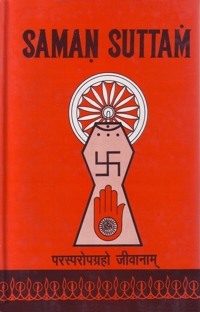31. Lesya Sutra
PRECEPT ON SOUL-COLOURING (LESYAS)
Homti kamavisuddhao, lesao piyapamhasukkao.
Dhammajjhanovagayassa, tivva-mamdaibheyao. (531)As a rule, the lesyas, (colours or tinges of the soul) are specifically mentioned to be of six kinds: (1) black (Krsna), (2) blue (Nila), (3) grey (Kapota), (4) golden yellow (Tejas), (5) lotus coloured (Padma) and (6) white (Sukla). (531)
Jogapautti lessa, kasayaudayanuramjiya hoi.
Tatto donham kajjam, bamdhacaukkam samuddittham. (532)Occurrence of soul-colouring as a result of activities (of mind, speech and body) due to the rise of passions is called Lesya. The twin effects of activity and passions is to bring about bondage of four kinds of Karma. (532)
Kinha nila kau, teu pamma ya sukkalessa ya.
Lessanam niddesa, chacceva havanti niyamena. (533)One engaged in the meditation called.'harma-dhyana' is possessed of three lesyas (soul-colouring), viz, yellow, lotus coloured and white - which are respectively more and more pure and are each divided into sub-types like intense, mild etc. (533)
Kinha nil kau, tinni vi eyao ahammalesao.
Eyahi tihi vi jivo, duggaim uvavajjai bahuso. (534)The black, blue and grey are the three types of inauspicious Lesyas; as result of these three (Lesyas) the soul takes birth in various-unhappy states of existence. (534)
Teu pamha sukka, tinni vi eyao dhammalesao.
Eyahi tihi vi jivo, suggaim uvavajjai bahuso. (535)The golden-yellow, lotus-coloured and white are the three types of auspicious Lesyas; on account of these three, the soul mostly takes birth in various happy states of existence. (535)
Tivvatama tivvatara, tivva asuha suha taha mamda.
Mamdatara mamdatama, chatthanagaya hu patteyam. (536)Each of the three inauspicious Lesyas differ in their intensity; most intense, more intense and intense; similarly the auspicious Lesyas undergo three changes; most mild, more mild and mild. And each of these sub-types is further subdivided into six classes in accordance with its relative increase and decrease. (536)
Pahiya je cha ppurisa, paribhattharannamajjhadesamhi.
Phalabhariyarukkhamegam, pekkhitta te vicimtamti.
Nimmulakhamdhasahu-vasaham chittum cinittu padidaim.
Khaum phalaim idi, jam manena vayaman have kammam. (537 & 538)Six persons who are travellers miss their way in the midst of a forest. They see a tree laden with fruits and begin to think of getting those fruits: one of them suggests uprooting the entire tree and eating the fruits; the second one suggests cutting the trunk of the tree; the third one suggests cutting the branches; the fourth one suggests cutting the twigs; the fifth one suggests plucking the fruits only; the sixth one suggests picking up only the fruits that have fallen down. The thoughts, words and bodily activities of each of these six travellers related to eating fruits are mutually different and respectively illustrative of the six Lesyas. (537 & 538)
Camdo na mumcai veram, bhamdanasilo ya dhammadayarahio.
Duttho na ya edi vasam, lakkhanameyam tu kinhassa. (539)The (mental) characteristics of a person of black Lesya are: he is violent; he does not give up enmity; he is quarrelsome, he is devoid of goodness and compassion; he is wicked and he cannot be influenced. (539)
Mamdo buddhivihino, nivvinani ya visayalolo ya.
Lakkhanameyam bhaniyam, samasado nilalessassa. (540)The (mental) characteristics of a person with blue Lesya are: he is dull; he is devoid of intelligence; he has no discrimination; and he is given to sensual enjoyment. (540)
Rusai nimdai anne, dusai bahuso ya soyabhayabahulo.
Na ganai kajjakajjam, lakkhanameyam tu kaussa. (541)The (mental) characteristics of a person with grey Lesya are: he frequently gets angry, censures others, blames others, is susceptible to sorrow and fear, and does not discriminate between what ought to be done and what not to be done. (541)
Janai kajjakajjam, seyamaseyam ca savvasamapasi.
Dayadanarado ya midu, lakkhanameyam tu teussa. (542)The (mental) characteristics of a person with golden yellow Lesya are: he knows as to what ought to be done and what not to be done; he knows as to what acts lead to welfare and what do not; he has always an attitude of impartiality, he is ever engaged in acts of compassion and charity, and he is soft. (542)
Cagi bhaddo cokkho, ajjavakammo ya khamadi bahugam pi.
Sahugurupujanarado, lakkhanameyam tu pammassa. (543)The (mental) characteristics of a person with Padma Lesya are: he is generous, honest, straightforward in his dealings, possessed of great forbearance and engaged in the worship of monks and preceptors. (543)
Na ya kunai pakkhavayam, na vi ya nidanam samo ya savvesii.
Natthi ya rayaddosa, neho vi ya sukklessassa. (544)The (mental) characteristics of a person with white Lesya are: he does not treat anybody with partiality; has no desire for future sensual pleasures, treats everybody with equality and he is devoid of affection, hatred and attachment. (544)
Lessasodhi ajjhavasanavisodhie hoi jivassa.
Ajjhavasanavisodhi, mamdakasayassa nayavva. (545)On the attainment of mental purification there will be purity in the Lesyas: it whould be understood that the subsidence of passions leads to attainment of mental purification. (545)
 Jinendra Varni
Jinendra Varni

